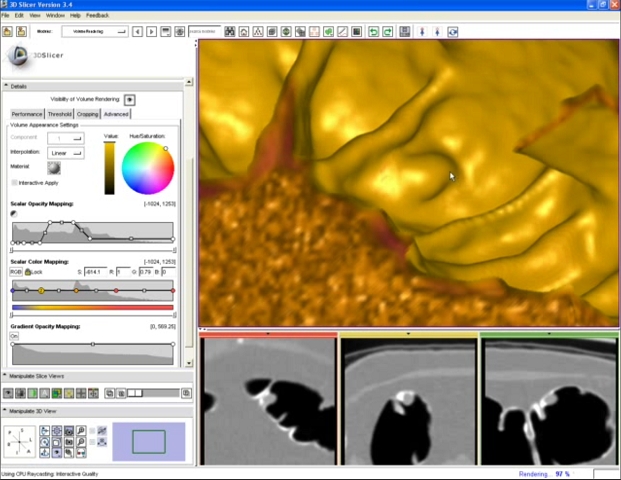Difference between revisions of "2010 NAMIC Project week: Real-Time Volume Rendering for Virtual Colonoscopy"
From NAMIC Wiki
| Line 1: | Line 1: | ||
__NOTOC__ | __NOTOC__ | ||
| − | + | ||
| − | + | [[File:VC-Slicer-75%.jpg]] | |
| − | |||
==Key Investigators== | ==Key Investigators== | ||
| − | * MGH: | + | * MGH: Hiro Yoshida |
| − | * | + | * MGH: Yin Wu |
| + | * Isomics, Inc: Steve Pieper | ||
| + | * BWH: Ron Kikinis | ||
<div style="margin: 20px;"> | <div style="margin: 20px;"> | ||
| Line 13: | Line 14: | ||
<h3>Objective</h3> | <h3>Objective</h3> | ||
| − | * | + | Pursure volume rendering that is suitable for real-time and interactive virtual colonoscopy display. |
| − | * | + | |
| − | * Compare the | + | The objectives of this project is to: |
| − | + | * Examine internal volume rendering engines (open source) availabel in Slicer | |
| + | * Provide external volume rendering engines (closed source) for virtual colonoscopy | ||
| + | * Compare the performance of these volume rendering engines. | ||
| + | * Compare the advantages and disadvantages of these volume rendering engines in real-time high-quality virtual colonoscopy navigation | ||
</div> | </div> | ||
| Line 23: | Line 27: | ||
<h3>Approach, Plan</h3> | <h3>Approach, Plan</h3> | ||
| + | Several virtual colonoscopy datasets will be rendered by use of the below volume rendering engines. | ||
| + | * VTK GPU Raycasting in Slicer 3.6 (GLSL) | ||
| + | * Microsoft research (MSR) volume rendering (CUDA, closed source) | ||
| − | + | The performance of these volume rendering engines will be compared based on various metrics, including the response to multitouch functions. | |
</div> | </div> | ||
| Line 31: | Line 38: | ||
<h3>Progress</h3> | <h3>Progress</h3> | ||
| − | + | The two volume rendering engines are installed on a single computer equipped with a CUDA-based GPU for rendering the virtual colonoscopy datasets and for performance comparison purposes. | |
</div> | </div> | ||
| Line 40: | Line 47: | ||
==Delivery Mechanism== | ==Delivery Mechanism== | ||
| + | A table that shows a comparison of the above two rendering engines in terms of | ||
| + | |||
| + | * rendering performance and | ||
| + | * advantages and disadvantages in rendering virtual colonoscopy datasets in clinical settings | ||
| + | will be delivered. | ||
==References== | ==References== | ||
</div> | </div> | ||
Revision as of 18:03, 21 June 2010
Home < 2010 NAMIC Project week: Real-Time Volume Rendering for Virtual ColonoscopyKey Investigators
- MGH: Hiro Yoshida
- MGH: Yin Wu
- Isomics, Inc: Steve Pieper
- BWH: Ron Kikinis
Objective
Pursure volume rendering that is suitable for real-time and interactive virtual colonoscopy display.
The objectives of this project is to:
- Examine internal volume rendering engines (open source) availabel in Slicer
- Provide external volume rendering engines (closed source) for virtual colonoscopy
- Compare the performance of these volume rendering engines.
- Compare the advantages and disadvantages of these volume rendering engines in real-time high-quality virtual colonoscopy navigation
Approach, Plan
Several virtual colonoscopy datasets will be rendered by use of the below volume rendering engines.
- VTK GPU Raycasting in Slicer 3.6 (GLSL)
- Microsoft research (MSR) volume rendering (CUDA, closed source)
The performance of these volume rendering engines will be compared based on various metrics, including the response to multitouch functions.
Progress
The two volume rendering engines are installed on a single computer equipped with a CUDA-based GPU for rendering the virtual colonoscopy datasets and for performance comparison purposes.
Delivery Mechanism
A table that shows a comparison of the above two rendering engines in terms of
- rendering performance and
- advantages and disadvantages in rendering virtual colonoscopy datasets in clinical settings
will be delivered.
